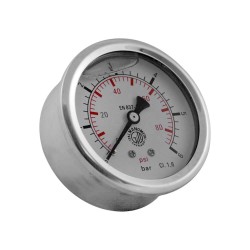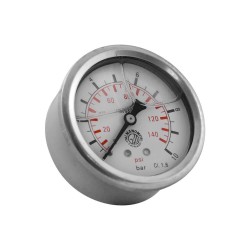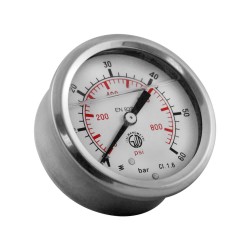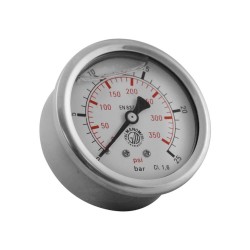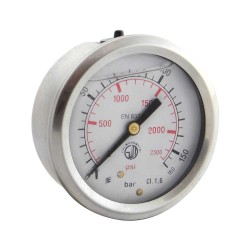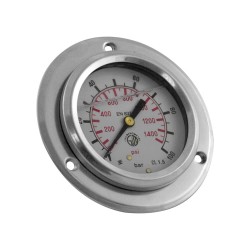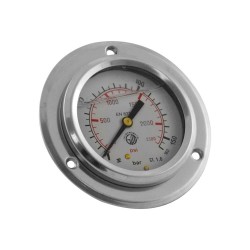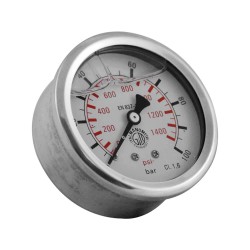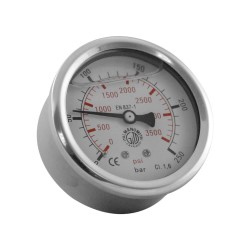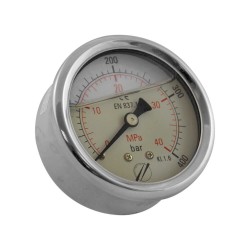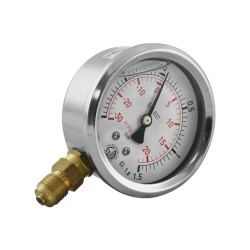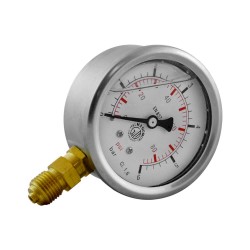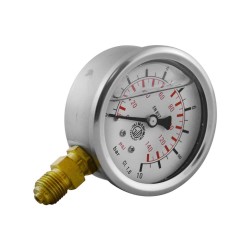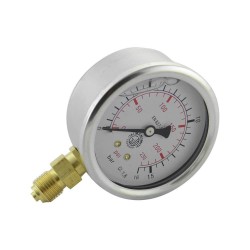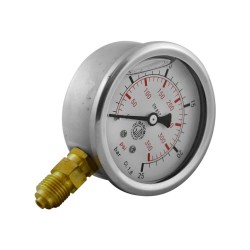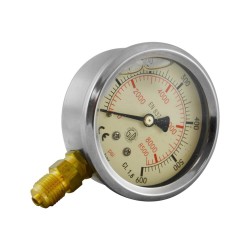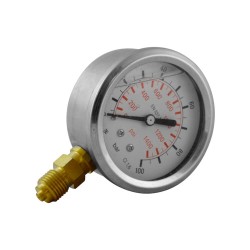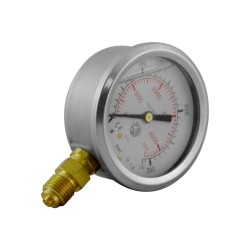Pressure Gauge: Operation A pressure gauge is an essential instrument used to measure the pressure of fluids, primarily in hydraulic and pneumatic systems. Whether for monitoring the pressure in a hydraulic network or checking the proper functioning of equipment, understanding how a pressure gauge works is crucial. Operating Principle The pressu...
Pressure Gauge: Operation
A pressure gauge is an essential instrument used to measure the pressure of fluids, primarily in hydraulic and pneumatic systems. Whether for monitoring the pressure in a hydraulic network or checking the proper functioning of equipment, understanding how a pressure gauge works is crucial.
Operating Principle
The pressure gauge generally operates on the principle of the deformation of a pressure-sensitive element. Here are the key steps in its operation:
Pressure Detection: When a fluid (liquid or gas) enters the gauge, it exerts pressure on a sensitive element. This element can be a U-shaped tube, a diaphragm, or a Bourdon capsule.
Pressure Transformation: The pressure exerted on this element causes a deformation. For example, in a U-tube manometer, the pressure alters the height of the liquid in both arms of the tube.
Pressure Indication: This deformation is then converted into needle movement on a graduated dial, allowing the pressure to be read in appropriate units (bars, psi, etc.). Some modern gauges are equipped with electronic sensors that display the pressure on a digital screen.
Hydraulic Pressure Gauge: Complete Guide
What is a Hydraulic Pressure Gauge?
A hydraulic pressure gauge is a device that measures the pressure of a liquid (usually oil) in a hydraulic system. These oil pressure gauges are designed to withstand the harsh conditions encountered in hydraulic applications, such as high temperatures and vibrations.
Operation of a Hydraulic Pressure Gauge
Sensitive Element: Pressure gauges use different sensitive elements to measure pressure, such as:
Pressure Indication: The deformation of the sensitive element is converted into needle movement on a dial or as an electrical signal for digital gauges. The user can then read the pressure in bars or psi.
Types of Hydraulic Pressure Gauges
There are several types of oil pressure gauges, suitable for different applications:
Analog Gauge: Simple and effective, it uses a dial and a needle to display pressure.
Digital Gauge: Offers precise and easy reading through a digital screen. Ideal for applications requiring higher accuracy.
Relative Pressure Gauge: Measures pressure relative to the atmosphere, commonly used in hydraulic systems.
Absolute Pressure Gauge: Indicates total pressure, including atmospheric pressure, often used for specific applications.
Applications of Hydraulic Pressure Gauges
Oil pressure gauges are widely used across various sectors:
Industry: To monitor pressure in machines and hydraulic equipment.
Agriculture: In spraying systems and agricultural machinery.
Automotive: To control pressure in braking and power steering systems.
Construction: In heating and plumbing systems.
Advantages of a Hydraulic Pressure Gauge
Safety: Monitors pressure to prevent accidents due to excessive pressure.
Efficiency: Helps optimize the operation of hydraulic systems by maintaining the appropriate pressure.
Maintenance: Allows for the detection of potential issues before they lead to major failures.
Difference Between Rear and Vertical Connection
There are several types of connections for pressure gauges, with the most common being rear connection and vertical connection. Here are the main differences:
Rear Connection: This type of connection is mounted at the back of the gauge. It allows for compact installation and is often used in confined spaces. The rear connection also facilitates mounting on flat surfaces, which is ideal for certain industrial equipment.
Vertical Connection: The vertical connection is located at the base of the gauge. It is particularly useful when the instrument needs to be mounted vertically, which is often the case in installations where pressure must be measured from below. This type of connection also allows better access for reading the pressure in certain configurations.
Different Diameters of Gauges
Hydraulic pressure gauges are available in a variety of diameters, usually measured in millimeters. Common diameters include:
40 mm: Often used for domestic applications or low-pressure systems.
63 mm: Ideal for standard industrial systems, providing good readability.
100 mm: Recommended for environments where precise measurements are essential and where the reading must be easily visible.
160 mm: Used in specific applications requiring very high precision.
The choice of diameter depends on the application and operating conditions.
Pressure Adjustment
Adjusting the pressure on a hydraulic gauge is essential to ensure the safety and proper functioning of systems. Here are the key steps for adjustment:
Pressure Check: Before proceeding with the adjustment, it is important to check the current system pressure using the gauge.
Adjustment: If the pressure needs to be modified, this is typically done via a regulating valve or a pressure regulator. It is crucial to follow the manufacturer's specifications during the adjustment to avoid overpressure or failures.
Validation: After the adjustment, it is important to check the pressure again to ensure it meets expectations.
Conclusion
The hydraulic pressure gauge is an essential tool for ensuring the performance and safety of hydraulic systems. Whether you are an industry professional or a hobbyist, understanding the operation and importance of this instrument can help you keep your equipment in good condition and avoid costly breakdowns.
OCGF specializes in the marketing of high-quality pressure gauges, tailored to the needs of professionals in various sectors. Don't hesitate to contact us for more information.

